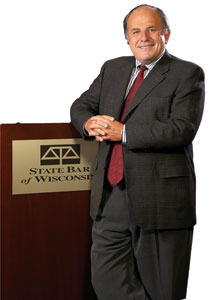 Wisconsin Lawyer
Wisconsin Lawyer
Vol. 78, No. 12, December
2005
Plan Tomorrow's Highway
The State Bar can best use its
resources by drawing plans today for tomorrow's highway.
 by D. Michael Guerin
by D. Michael Guerin
"Failure to plan on your part does not constitute an emergency on my
part." - Unknown
Anyone who knows me knows that I do not live by this quote. To the
contrary, I am more likely to have these words said to me rather than
speak them myself. That said, I recognize that planning, while sometimes
painful, is critical in running any organization. In an organization as
large and diverse as the State Bar, it is easy to lose our way on the
road to success by getting bogged down in parochial matters. Thus, we
must take a step back and look at what is truly important to the State
Bar as an organization.
As many of you already know, in July the Board of Governors approved
the Bar's refocused strategic plan. The next significant step requires
committees, sections, and divisions to also undergo strategic planning,
a process that already is underway for many entities.
The current strategic planning process actually began in 2003 under
the tutelage of president Pat Ballman and Strategic Planning Committee
chair Cory Nettles, and was most recently led by president Michelle
Behnke. At that time, leaders faced the perennial issue of having
greater demands than limited Bar resources could accommodate. To aid in
decision making, leaders began a strategic planning process to
rationally allocate existing Bar resources while also ensuring that the
Bar as an organization achieves its mission. Bar leaders and staff have
since been working in tandem on strategic planning to refine the Bar's
mission, vision, and priorities.
The mission of the State Bar of Wisconsin is to improve the
administration of justice and the delivery of legal services and to
positively promote the professional interests of Wisconsin lawyers.
That's a lofty and very broad mission. To help us achieve this mission,
the Bar has set four key priorities: improving public access to the
legal system; encouraging member engagement in the Bar; increasing the
public's understanding of the legal system; and improving the Bar's
relevance to our members.
Simply put, strategic planning is a critical way of looking at what
the Bar does or should be doing instead of simply "maintaining the
status quo." Keeping our priorities in mind, Bar leaders are reviewing
the products and services that we deliver and how members use these
services. We are looking at the challenges facing law practices. We are
looking at public access to and understanding of the legal system. We
are using this plan as a tool to evaluate the process by which we are
accomplishing what we need to accomplish. We are working on making
ourselves accountable for our actions. We are now at a critical
juncture, because we are marrying the strategic planning and the
budgeting processes to effectively allocate available funds for these
priorities.
The Bar's strategic planning process has had some unintended
beneficial consequences, including the sharing of information among
committee and division leaders about what their groups do. This kind of
information sharing reveals connections that foster shared goals and
collaboration. Another benefit is the opportunity for Bar and volunteer
leaders and staff to learn about each other, about how the Bar truly
works, and about what resources are necessary to keep "the rubber on the
road." During strategic planning sessions, many Bar members engaged in
focused discussions on issues and challenges surrounding their groups'
purpose and work. This discussion, unprecedented in past planning, is
due, in large part, to the process that is used, which includes creating
SMART (specific, measurable, attainable, results-based, and time-bound)
goals that also are wise goals. Continual communication is a good
thing.
Volunteer leaders (including me) who initially approached the
planning process with skepticism now report that the process was
valuable in creating a roadmap for activity by which results can be
measured. Many participants were fully engaged in planning to a depth
that surprised even them.
The Bar's financial planning and budgeting processes have evolved in
concert with the strategic planning process. During tight budget times,
strategic planning can help us apportion limited resources to accomplish
our organization's goals and to evaluate our performance and the
effectiveness of individual projects in accomplishing our goals.
No strategic plan can succeed without member input. With your help,
the end result will be a road to the future that is a paved, four-lane
highway that is, we hope, free of speed bumps.
Wisconsin
Lawyer
